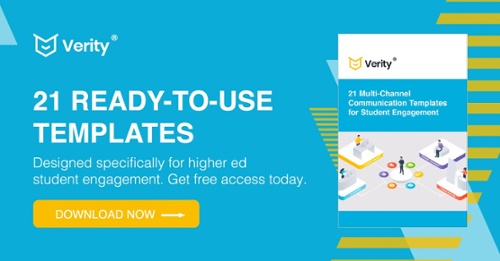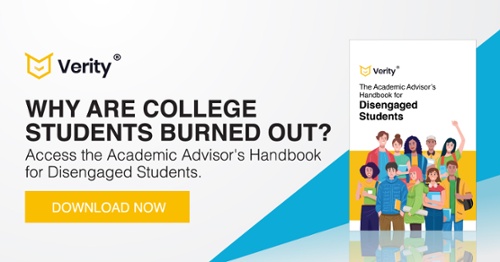The Power of One: A Higher Ed Roadmap to Effective Student Lifecycle Management
The Student Lifecycle Roadmap
Mapping out the student lifecycle in a proactive, meaningful way is the best way to create a positive student experience.
It doesn’t just start with enrolled students—your lifecycle management strategy should be built out from the very first interaction that potential students have with your school, before you even know who they are.
To do this effectively, you’ll need a winning roadmap strategy in place along with the right Student Information System (SIS) to power it, both of which will help you manage the entire student lifecycle.
A good SIS will also help you leverage powerful process and communication workflows to ensure compliant record keeping, accurate reporting, and decision-making based on real-time analytics.
No two student lifecycle management strategies are the same because each school offers unique programs, curriculums, and overall experiences.
However, we’ve compiled some of our favorite strategies, best practices, and helpful tips that we’ve learned from working with hundreds of higher education institutions over the years.
And now we want to share them with you through a sample roadmap that's broken down for each step of the student lifecycle:
- Suspects
- Prospective Students
- Applicants
- Enrolled Students
- Current Students
- Alumni
Happy learning!

Suspects
 Target Persona
Target Persona
The term “suspects” refers to people who are engaging with your brand in some way, like visiting your website, interacting with a social media post, or even looking at a print ad. However, you most likely don’t know them because they haven’t actually raised their hand yet.
Suspects are still very much at the surface level and are looking for something that grabs their interest. At this point, they’re mostly wondering if your school is worth their time (and money).
 Goal
Goal
Your goal for targeting new suspects is to get that first conversion on your website so that they share a little bit of information about themselves—their name and email address at a minimum. Even better if they provide their phone number.
Ideally, we’d also like to learn about their program of interest. Are they exploring undergrad or graduate programs? Have they picked an area of study already? Would they be a transfer or are they enrolling as a new student?
 Overall Strategy
Overall Strategy
Your job is to make it as easy as possible for the suspect to engage with your school and express interest. Always provide clear direction on what next steps they should take, whether it’s learning more on the website, filling out a form, or subscribing to your mailing list.
This is where the importance of having a clear student roadmap starts to take shape, and doing so will provide an awesome experience for your suspects.
And remember, everyone has their own preferences for interacting with schools, including:
- Social media
- SMS text
- Live chat
- Virtual reality (VR)
It’s a good idea to leverage both traditional and digital conversion points that cater to the individual’s preferences, whatever they are.
 Key Departments
Key Departments
Your Marketing & Communications team should be owning this process. Make sure your school’s value propositions are clear and shine through with every interaction. To cater to digital preferences, you should also ensure that your website is mobile-friendly.
With clear conversion paths outlined for them, the suspects who interact with your school are much more likely to take those next steps.
 Helpful Tips
Helpful Tips
Because you don’t know much about them yet, suspect data can become scattered across multiple systems when they interact with you. When this happens, you might not always be able to tie multiple actions to the same person.
However, if you use one platform to track and record student lifecycle data, you’ll get the full view of the suspect’s record and know exactly when they take that first step.
Another helpful tip to keep in mind at this stage is not to ask for too much information upfront (i.e., birthdate, mailing address). That may deter suspects from taking that first step. There will be plenty of opportunities to nurture them down the road and obtain that information over time. But first, you’ve got to get them in the door.

 Target Persona
Target Persona
Prospective students are people who’ve already converted once, perhaps on a piece of top-of-funnel content (like an eBook) or a request more information (RMI) form.
Now you’ve got some basic information on this prospect, such as their name and email address. Bonus points if you have their phone number, mailing address, and program of interest as well!
You should also be on the lookout for re-inquiries as well. These are prospects who've inquired before, maybe advanced to some milestone in the student lifecycle, but then dropped off somewhere along the way.
Now, they’ve raised their hand again. This is totally normal—it often takes multiple conversations with prospects until a final decision is made. Additionally, visibility into previous intent and conversation is priceless when engaging with re-inquiries. That’s why it’s great to have a software tool that records that full history in one place and makes it easily accessible for future conversations with your prospects.
 Goal
Goal
The primary objectives at this stage are to make a good first impression, proactively answer questions, and make yourself available to answer questions without being pushy (more on that in our blog, The Dos and Don’ts of Texting Prospective Students). And, you want to do all of this in a digital format that meets student expectations.
Ultimately, your job at this stage is to qualify and nurture as many of your prospects into applicants as possible, both by letting the prospect explore on their own and by being responsive when they reach out directly for help.
 Overall Strategy
Overall Strategy
Prospective students at this stage are exploring their options and they want to know:
- What differentiates your school from others
- Whether or not you offer an area of study that interests them (and if they should pursue it)
- How challenging the application process is
- What intangibles they can expect to experience on-campus that make your school unique
So, your strategy should be to communicate with the prospects regularly (automatically, manually, or both) and become a friendly, valuable, encouraging, and positive resource for them. The more personalized the communication, the easier it is for the prospect to feel valued and welcomed at your institution.
Multichannel communication is important at every stage, but you’ll find that it will play a big role in helping you hit your goals (in this case, qualified applications).
Building effective conversion paths and proactive nurturing campaigns will also take the pressure off of your Marketing and Admissions teams. You’ll have a clean, sophisticated process laid out in an automated way that gets results, and frees up your staff to focus on other important initiatives.
So, communicate with your prospects through multiple channels (i.e., phone call, SMS/MMS, email, video, and chat) to appeal to different students’ preferences and provide them with every opportunity to take the next step with your school.
Looking for actionable, ready-to-use templates? Download our guide: 21 Multichannel Communication Templates for Student Engagement!
These templates will help you drive engagement throughout the entire student lifecycle, including admissions, advising, career services, and more!

Applicants
 Target Persona
Target Persona
Turning your prospects into applicants is a huge milestone in the student lifecycle journey. However, not all applicants actually finish their applications.
So, we’re going to focus on those prospective students who’ve started the application process but haven’t actually submitted them.
It could be that the applicant got stuck during the application process, started doubting their decision, or is considering other options. Maybe they need help but aren’t sure where to turn.
 Goal
Goal
Obviously, the goal here is to get these students to finish and submit their applications before the deadline. It takes a good bit of momentum to reach this student lifecycle stage, momentum that can be easily lost if the applicant doesn’t hear from you.
This is actually quite a common scenario in higher ed, but so few schools have a well-defined strategy for helping those prospects across the finish line. This is where you can be a difference-maker.
The secondary goal is to become their first choice institution, if you’re not already. They’ve obviously shown some interest in your school at this point, and now you have a chance to be #1 on their list.
 Overall Strategy
Overall Strategy
Your approach here should be to remind prospects that their application is still incomplete and to make sure they submit it by the deadline. Simple, right?
However, we don’t want to simply send reminders to their inbox. Avoid transactional types of interactions that make the prospect feel like just a number. It won’t create the amazing student experience that you should strive for, and it’s a quick way for your emails to start being ignored.
Instead, offer guidance in the form of FAQ pages, a calendar link to meet with an Admissions team member for guidance, and any other helpful resources you have. Let the applicant know that you have a personal interest in them and are here to help them navigate the application process.
 Key Departments
Key Departments
Application nurturing typically falls on the Admissions department. This is a critical stage to present the school as a trusted, valuable resource in their corner and NOT a “robotic” entity that’s droning on about deadlines and requirements. It’s an important balance to strike.
Keep in mind that at this stage especially, there needs to be a consistent approach to communication that creates a good impression and starts building the personal relationships for which you strive.
 Helpful Tips
Helpful Tips
Make sure that you have a platform built for scalability and smart reporting. For example, you should have insight into whether or not a contact has performed the desired action of your campaign or not and adjust accordingly.
In this case, if the student has completed the application, they should be unenrolled from getting reminders about the deadline!
Another tip is to go paperless with automated workflows for document gathering and electronic signatures. This should start with the application for enrollment through financial aid onboarding and externship site approvals.

Enrolled Students
 Target Persona
Target Persona
We’re now targeting students who’ve been accepted to your school and are preparing to start (or continue) their educational journey with you. These are students who have committed to attending your institution and have likely submitted their deposits.
It’s important for these students to still feel engaged and involved with your school between the time they’re accepted and their first day on campus. Enrolled students will likely have additional questions, like what they need to do to prepare for school and what they have to look forward to.
 Goal
Goal
The primary goal is to make sure that your enrolled students are prepared for the upcoming semester and everything that entails.
You also want to validate them and help them see they made the right decision by applying for and committing to your school. Remember, this is a huge decision for them and their families, so you really want to make sure that you’re putting out a warm and welcoming vibe that makes them feel good about their decision.
 Overall Strategy
Overall Strategy
The last thing you want to do is get caught being reactive and only providing your students with the things they need when they ask for them. It makes you look disorganized and creates a less-than-ideal student experience.
So, you should build a proactive campaign to make sure your enrolled students are registered for classes, have rooming and meal plans figured out, have their parking pass, are invited to orientation, know their financial deadlines, and things of that nature.
Aside from those logistical items, you also want to make sure that enrolled students feel a connection with your institution and their classmates. They should feel included in any social events, student mentor opportunities, and other available community events.
What you don’t want to happen is that classic “summer melt” where accepted students lose momentum, don’t engage with the school, and aren’t prepared when they arrive.
 Key Departments
Key Departments
There are many different departments that will likely have roles to play here: Admissions, Campus Security, Financial Aid, Registrar, etc.
Work together to build a uniform strategy with a consistent approach. You don’t want to run into conflicting messages, multiple emails going out the same day, and an inconsistent brand message.
 Helpful Tips
Helpful Tips
When handling critical documents like registrations, transcripts, and other important information at this stage, you want to make sure that they’re organized, easily accessible, and most importantly...secure (and the best SIS platforms allow you to handle this digitally).
Ideally, the same platform you’re using to communicate with students is the same one you’re using for document and contact management.
This will allow you to:
- Create and manage inventories of forms and program-required documents
- Define document signature workflows for multiple parties
- Completed documents are stored securely and easily accessed by staff and students
One more tip: a single comprehensive student record is invaluable, especially when it’s being used across departments. Always work toward one student record that can be updated as different departments collect data from them.
Why Do Students Become Disengaged?
College students are experiencing record levels of anxiety and burnout.
When people are burned out, they tend to disengage. As an academic advisor, recognizing those signs of disengagement early and having ready-to-go plans in place are key to the role.
Use this guide to help recognize the early signs of student burnout and disengagement before the “point of no return.” Learn how to catch these trends early and build a proactive plan to get students back on track.

Current Students
 Target Persona
Target Persona
These are enrolled students who are more or less actively attending classes.
Current students want a solid foundation with your institution and the confidence that you’ll provide them with important information they’ll need (not just messages for the sake of sending messages). You want them to see you as a helpful resource–not a nuisance every time a new message hits their inbox.
As they pursue their studies, current students want to know more about what’s happening on campus, what important dates and deadlines are approaching, and any big news at school.
 Goal
Goal
The specific goals will change, depending on the situation and the campaign you’re running. For example, maybe you’re helping students register for classes, meet with their advisor, or sign up for an upcoming event.
The overall goal remains the same across campaigns: ensure that important messages are seen and understood by current students.
 Overall Strategy
Overall Strategy
Let’s face it: students are busy.
Between classes, sports, extracurriculars, and their social life, they have a ton of things demanding their attention (especially if you have a thriving campus!). Your job is to cut through the clutter and get your message heard. Always be sure that messages are worth sending and that if something is crucial for a current student to see, it’s made very clear to them (and sent again as needed).
Leveraging a good marketing workflow automation tool is a great way to build complex, cross-platform campaigns in a cohesive and results-driven way.
Automation also allows you to give your students an exceptional experience because you’re building a proactive, intentional campaign instead of just putting communications together whenever you have something to share.
 Key Departments
Key Departments
The teams involved will also depend on the given campaign, whether it’s related to the Registrar’s Office, Campus Security, Residential Living, Student Activities Committee, or Career Services.
Once again, a uniform communication strategy across departments is a must to keep branding consistent and avoid unnecessary confusion.
 Helpful Tips
Helpful Tips
As you build and maintain your SIS, you want to make sure that all of your records meet the proper compliance and reporting criteria.
It’s important to ensure that you are as close to single records for each individual as possible for the cleanest and most accurate compliance data. Data should be kept clean across systems and regularly combined manually, if needed, to keep everything as error-free as possible.
Doing this well will make the lives of all involved departments way easier when they don't need to constantly import/export data in spreadsheets or track reporting manually. This also helps create better-segmented lists for more personalized student communication.

Alumni
 Target Persona
Target Persona
These are individuals who have graduated from your institution. They likely want to stay up-to-date on your institution—but not just when you want money or volunteers. Some alumni may be interested in contributing to your school, but they’re looking for compelling reasons that remind them of their time with you.
 Goal
Goal
The goal here is to maintain a strong sense of community with former students so that they stay engaged, encouraging them to return to campus for continuing education, attend networking events, and give back.
 Overall Strategy
Overall Strategy
Multichannel communication is going to be crucial here. As your alumni grow older, their preference for communication will evolve over time. So, it’s important to communicate across multiple channels (email, phone, SMS text, mail, etc.) so you can reach your alumni wherever they are. You don’t want your alumni to feel like you’re pestering them, but you do want to stay top-of-mind.
Equally important is that your team makes a concentrated effort to keep updated records for your alumni (especially things like address and phone number) in one place. If you don’t, it will be easy for your database to become obsolete with outdated information. You’ll also need the most current information for job placement reporting and similar initiatives.
 Key Departments
Key Departments
This will vary depending on the school, but primarily it’ll be your Alumni Association who’ll handle outreach, event coordination, and fundraising (in coordination with your Giving office).
Your Career Services department may also get involved to handle placement reporting, mentorship/internship opportunities, and alumni networking.
 Helpful Tips
Helpful Tips
It’s a great idea to segment your contacts by common traits, such as graduation year or geographic area. That way, your lists are organized for future campaigns.
For example, if you’re running a campaign for alumni events across the country or you’re inviting a class back to campus for its reunion, your lists are all cleaned up and ready to go.
You guessed it—whenever possible, strive to also store job placement data in one record for each student. Now you have a full view of their history, starting all the way back when they first engaged with your school!

The Power of One
Many higher ed institutions have legacy systems that don’t support full student lifecycle management—they’re outdated and don’t communicate with one another. This can present many headaches, including limited capabilities, untrustworthy data, and way too much manual work.
Doing everything on one platform hasn’t been an option… until now. Introducing Verity Student: the SIS of the Future.
Now that Student is here, effective student lifecycle management can be achieved at all-new levels. You deserve an all-in-one platform that can:
- Consolidate all student data and interactions into one record
- Offer multichannel communication in one place
- Automate tasks, communication, scheduling, etc.
- Provide meaningful, accurate data in real-time
One platform. One source for your data. One version of the truth.
When you use the right platform to build an effective student lifecycle management strategy, you’ll experience MORE applicants, INCREASED enrollment, HIGHER retention rates for existing students, and STRONGER student engagement.
So, what are you waiting for? See how Verity Student can put your institution ahead of the curve today.
What Does Your Roadmap Look Like?
This guide outlines a sample roadmap, but every school is unique and has a unique target audience. You need to build a roadmap that fits your situation and calls out all of the wonderful unique value propositions that make your school special.
Hopefully, reading this guide has given you some great ideas to get started.
But first, you need the right software stack that’s capable of supporting your vision for student lifecycle management.
If you’re ready to take your strategies to the next level, let’s talk!








